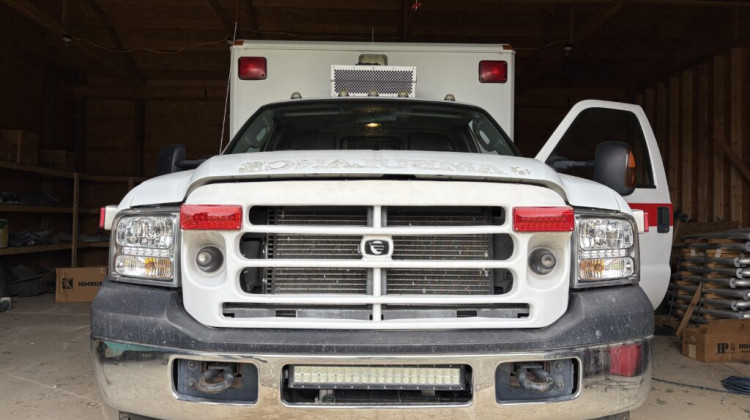
The Indiana Women's Prison, a maximum-security facility in Indianapolis, houses incarcerated women with significant health needs. Women with suicidal ideation can be placed on suicide watch, where their incarcerated peers observe them one-on-one.
(Elizabeth Caudle/Side Effects Public Media)A note to readers: This story contains descriptions of self-harm. If you’re struggling with suicidal thoughts, help is available. Contact the National Suicide Prevention Hotline at 800-273-8255 or the Crisis Text Line by texting HOME to 741741.
Phone calls from her mother were usually a comfort for Char’Dae Avery, 29, while she was incarcerated at the Indiana Women’s Prison in Indianapolis. But a few years ago, her mom started delivering bad news. Her brother, who was also in prison, got into a fight and was severely injured. Her dad was in an accident.
As her anxiety mounted, Avery felt she was in crisis and needed counseling. Late one night, she went to the only person she could ask for help: a correctional officer.
“They were like, ‘Well, it's too late. We don't have anybody here for you to talk to,’” Avery said.
She remembers the guard told her the only way she could leave her dorm would be to tell them she was going to harm someone or harm herself. She didn’t think she was suicidal, but with no other options, she told them she was.
“I said, ‘Well, I'm not in my right state of mind and I feel like I'm going to hurt myself,’” Avery recalled.
Avery was placed on suicide watch. She traded her khaki prison uniform for an anti-suicide smock: a sleeveless dress made of thick material that’s difficult to tear or tie into a noose. She was given a thin mat to sleep on and sent to a cold, padded cell with a window in the door.
Avery fell asleep. When she woke up, there was someone outside staring at her through the window.
Avery remembers the woman telling her, “You're going to be OK.” It wasn’t a doctor, or a counselor. It was another incarcerated woman.
Outside of prison, people on suicide watch are constantly monitored by a mental health professional in a hospital or treatment center. But in prisons in Indiana and several other states, it doesn’t work that way. The person watching an inmate on suicide watch isn’t always a trained professional or even a guard. Instead, it’s often another incarcerated individual, known as a suicide companion.
Indiana implemented its suicide companion program in 2006 after a spate of suicides. The approach can cut costs for prisons and help address staffing shortages. But some individuals who have served as suicide companions say the experience took a toll on their own mental health.
Taking advantage of an 'abundant resource'
Each month, suicide companions in Indiana’s prisons monitor dozens of people on suicide watch. Prisons in Kansas, South Carolina, Michigan and New Mexico also use suicide companions. Federal prisons have used suicide companions since at least the 1980s, and prisons outside the U.S. have similar programs.
“We've kind of gotten this idea of: Let's use our most abundant resource in the correction setting, which is inmates,” said Christine Tartaro, a professor at Stockton University in New Jersey who studies suicide in prisons and jails. “Every prison has an abundance of inmates.”
Tartaro said companions aren’t meant to replace trained mental health staff.
“It could be tempting for budget-minded corrections facilities to just say, ‘Oh, we have these inmates. Therefore, I don't need to hire a psychologist. I don't need that social worker,’” she said.
Other mental health experts who spoke with Side Effects were divided on the use of incarcerated people as suicide companions, given their lack of professional qualifications.
“If you're thinking of therapeutic ways to deal with a person who is at a crisis point in their lives, it would never be your first thought [to say], ‘Let's have someone sit silently next to them for hours or days on end.’ Like, no one would do that,” said Dr. Reena Kapoor, a professor at Yale University who also works as a prison mental health consultant.
“I just don't think that in those most acute moments where someone's on suicide watch that … you should put that responsibility for keeping them safe on another inmate. To me, that's a responsibility for health care professionals,” she said.
But Tartaro said she sees the benefits of the suicide companion approach. Prisons are often understaffed, especially when it comes to counselors, and people in crisis may trust their peers more than doctors or guards.
In Indiana, the suicide companion program also helps cut costs.
“We're talking hundreds of thousands of dollars saved every year in staff overtime,” said Bill Elliott, a psychologist who helped implement Indiana’s program. “The rewards were as much for the person being the companion as they were for the inmate patient who was being watched. It gave them a sense of meaning and fulfillment.”
A small 2005 study also found using suicide companions in federal settings reduced the time a suicidal individual spent on watch.
New trauma caused by the program
While suicide companion programs may help prisons save money, some former companions caution that those benefits come at a cost.
Lori Logan, who was a companion for four years at the Indiana Women’s Prison, said her experience took a toll on her own mental health.
Years later, Logan said she can still vividly remember one particularly horrifying shift, during which a woman smuggled a razor blade with her into the cell.
“I noticed her shoulder was moving and I asked her what she was doing,” she said. “Next thing I know, half the wall was bloody, and I was screaming for an officer.”
Logan and other former suicide companions in Indiana told Side Effects they received little training to do the job and struggled to cope with what they experienced. Incarcerated women, in particular, can have histories of trauma, and working as suicide companions traumatized them in a new way.
They watched women pull out their hair and ingest their own bodily fluids; they choked on pepper spray they said guards used to subdue the women on suicide watch.
The former companions also said once they signed up, they were forced to do the job. If they refused, they said correctional officers told them they would be written up, which could result in disciplinary action such as solitary confinement or losing visitation privileges.
Indiana Department of Correction officials declined multiple requests for an interview with Side Effects. In an email, spokeswoman Annie Goeller disputed the stories multiple women shared. She said the companions receive training, can debrief with staff after hard shifts, and aren’t penalized for asking for help. Goeller also said the program is voluntary.
After trying to quit multiple times, Logan eventually walked off of an especially hard shift a few years ago.
“I was watching the girl hurting herself in front of me,” she said. “I stood up. I threw my pen across the lock unit and I said ‘I quit.’”
Logan said she wonders whether she would have ended up on suicide watch herself if she had continued as a companion.
From suicide watch to suicide companion
After Logan ended her involvement with the suicide companion program, new companions took her place. One of them was Char’Dae Avery, who was placed on suicide watch when she hadn’t truly been suicidal. She met with a prison counselor and was released after a few days. About a year later, Avery became a suicide companion.
She said prison staff thought her experience on suicide watch could make her a better companion to other women.
“I could relate to them more, because I’d been where they are,” Avery said.
Her experience was similar to Logan’s. Avery watched women run into their cell walls and self-mutilate by picking at their skin.
Despite the horrors she witnessed, Avery said it was a rewarding experience.
“I was basically always serious all the time. I was emotionally dead. I didn't have any emotions,” Avery said. “Being a suicide companion definitely showed me how to open up, emotionally.”
Avery left the Indiana Women’s Prison in summer 2020. Even with the personal growth she experienced as a suicide companion, she said she believes those roles should be filled by trained mental health staff.
“It will help the people who are behind the glass more,” who are struggling with suicidal thoughts, Avery said. “If they're getting the help that they need, maybe you'll stop seeing them as often.”
You can listen to a longer version of this story in the second season of Sick, a podcast from WFYI and Side Effects Public Media about what goes wrong in the places meant to keep us healthy. Download all five episodes wherever you get podcasts, or listen at sickpodcast.org.
This story comes from Side Effects Public Media — a public health news initiative based at WFYI. Follow Lauren and Jake on Twitter: @lauren_bavis and @jkhrpr.
9(MDAyMzk1MzA4MDE2MjY3OTY1MjM5ZDJjYQ000))
 DONATE
DONATE





 View More Articles
View More Articles



 Support WFYI. We can't do it without you.
Support WFYI. We can't do it without you.